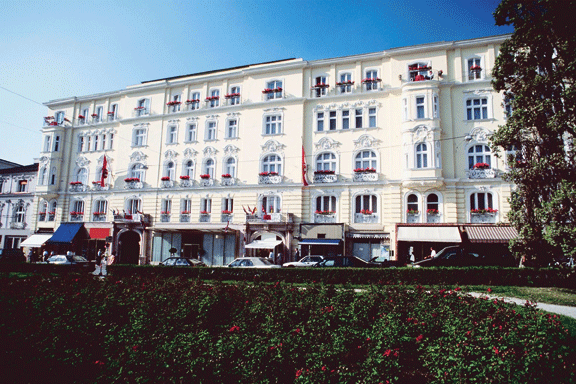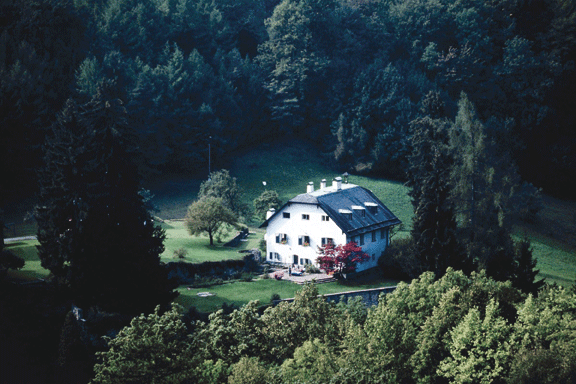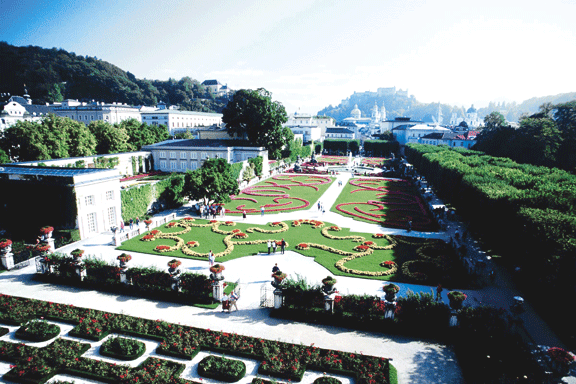
Travel
Salzburg
Land of Music,
Mountains and Mozart

Wedged between three snow-capped peaks and dotted with medieval turrets and resplendent Baroque palaces, Salzburg is the capital of the province of the same name and the gateway to Austria from the northwest. Although admired for its beautiful buildings and stunning setting the city’s raison d’etre is music, particularly the sounds of its favourite son, Wolfgang Amadeus Mozart.
By: Veronica Maria Garbutt
The composer’s presence can be felt throughout the city from the Mozartplatz with its monument to Mozart to the Mozarteum music academy, Mozart’s birthplace and residence. The city’s admiration peaks every year during the Salzburger Festpiele (summer music festival), a five-week celebration of opera, orchestral music and theatre that begins in July.
The city straddles both banks of the river Salzach which flows from the Salzburg Alps into Lower Land dominated by the Untersberg which soars to over 6,000 feet. The massive Festung Hohensalzburg (fortress) towers over the romantic old town with its narrow medieval streets, arcaded courtyards and tall narrow houses. Between Neutor and Neugebaude is a princely Baroque residential area with ornate building and stately squares. Not surprisingly, Salzburg is a UNESCO World Heritage Site.
Although there is evidence of Neolithic, Illyrian and Celtic settlements in the area the Roman town of Salzburg was founded in the first century. In the 6th Century it was occupied by the Bavarians. Later the province of Salzburg became one of Europe’s most powerful statelets until it was swept away by Napoleon in 1800 as French troops advanced upon the city. At the 1815 Congress of Vienna, Salzburg was awarded to Austria. The region’s wealth was based on “white gold” – salt (salz in German, hall in ancient Celtic) from which the city’s name is derived.
Getting around the city is easy. From the Haupthanhof you can take a bus downtown to the Neustadt (new town) centred on Mirabellplatz. Then walk over to the Alstadt (old town) crouching beneath Monschberg Mountain. Allow plenty of time to explore the many squares, courtyards, fountains, markets and cafes of the old town. The main river crossing-point into the Alstadt is Staatsbrucke bridge.
After passing under the archway of the 15th Century Rathaus (town hall) turn right into the pedestrianized Getreidegasse, lined with fancy boutiques and characterized by overhanging wrought-iron shop signs. At No. 9 Getreidegasse stands the house where Mozart was born. On the third floor where the Mozart family lived there is now a museum complete with memorabilia including portraits, a clavichord and young Wolfgang’s violin.
Continue eastwards along Getreidegasse and you will come to Kranzmarkt. Rising slightly to the south is the Altermarkt which dates back to the 13th Century. At No. 6 is the Court pharmacy established in 1591 and No. 9 is Café Tomaselli, a Salzburg institution and a great place to rest awhile over a cup of chocolate accompanied by gooey cakes and pastries.
Revitalized by all those calories you will have the energy to explore the narrow, twisting lanes of the Altermarkt which extend to the Kaiviertel (Quay Quarter). No. 11 Pfeifergasse was home in 1525 to the physician and philosopher Paracelsus. And at No. 3 Hellbrunner Strasse is the Kunstlerhaus (Artists’ House) which offers special exhibitions from time to time.
To explore Hohensalzburg castle and fortress, make your way over to Festungsgasse and take the cable car to the top of the hill. Built between 1077 and 1681 the fortress is now Europe’s most completely preserved castle. In order to see the interior, visitors must take a conducted tour which includes the “Salzburg Bull” organ, the Princes’ Apartments, Gothic staterooms, torture chambers and the impregnable watchtower which offers an unrivalled view of the city.
After exploring both the Ranier and Fortress museums up here you can meander down leafy pathways to the Alstadt or take the Monchsberger lift. But don’t forget to enjoy an al fresco lunch atop the Monchsberg before descending. Below Festungsbahn is Kapitelplatz, home of a giant chess grid, a fountain depicting Poseidon and a colourful market where you can buy everything from local cheese and meats to hot fresh bread and pretzels.
Over on the right bank lies the more modern part of town, the business centre and location of several galleries, theatres and gardens. At No.26 Schwartzstrasse is the Mozarteum built in 1910-14 for the College of Music and Performing Arts. Nearby lies Schloss Mirabell, a castle which houses municipal offices and many of the mayor’s sumptuous offices are open for public viewing. The castle also hosts classical concerts in the evening in the elegant Marble Hall.
Just south of the castle lies the Mirabellgarten, a fine example of Baroque landscape gardening completed at the end of the 17th Century. The gardens which come complete with fountains, terraces and marble statues are a good place to relax and were featured in The Sound of Music. Fans of the film might be interested to know that you can take a guided tour of the various film locations in and around town including the Opera House, Schloss Leopoldskron, Schloss Hellbrun and Mondsee.
If you are a really keen fan don’t miss The Sound of Music dinner show at the Steigkeller restaurant. Here, while waiters ply you with schnitzel and noodles plus apple strudel, performers sing a medley of favourite film songs. Other recommended places for Salzburg specialities include Zum Fidelen Affen (excellent spinach spatzle and beef with onion gravy), Sur Goldener Ente (where the duck is delicious) and Villa Pace (excellent lamb dishes in a rustic setting).
For shopping and souvenirs for friends and family back home, you can find many present possibilities on Getreidgasse. Good buys include china, glassware and embroidered crafts which you can find at Salzburger Heimatwerk at No.9 Residenzplatz. A fun flea market can be found at the Monchberg Lift end of the street of signs. Organic produce and dried flowers can be purchased at the open-air markets of Mirabellplatz and Universitatplatz along with the ubiquitous Mozart chocolates and confectionery.
If you have time to spare consider a day trip (or longer) to Salzburg province, or Salzburger Land as it is locally known. Just south of the city lies Hellbrun Palace with a sprawling estate complete with fish ponds, topiary and tree-lined pathways. And further south are mighty mountain ranges towering above alpine villages, waterfalls and ski resorts. Here Hohe Tauern National Park is a magnet for walkers and aficionados of the great outdoors.
Every three years on the last Sunday in July a Pirates Battle is held on the Salzach River at Oberndorf which lies almost 10 miles north of Salzburg. To the northeast of the city are the Salzburg Lake Flats, the largest of which is Wallersee plus the summer resort of Mattsee. The best time to visit is between May and September when there is a good chance of sunshine. But if you are coming for the Salzburger Festpiele, time your trip between the last week of July and the end of August. Happy Journey!